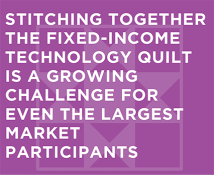
The front-to-back electronification of the fixed-income market has created tremendous efficiency for everyone, from issuers to market makers to investors.
Markets are more transparent, liquidity is easier to tap, and trades are easier to analyze and process than ever before. And while recent market volatility strained fixed-income markets globally, higher levels of electronification as compared to the 2008 financial crisis have left market participants considerably more informed and markets open where they may have otherwise gone dark.
Case in point: The market for U.S. Treasuries saw over $1 trillion dollars in bonds trade each day throughout the first week of March—a record.
Despite these benefits, what once required a phone, some broker relationships and a good operations staff now requires APIs, real-time data and front-to-back trade automation. This process evolution has also driven a transformation in the skills that trading desks are seeking out in new candidates, with data analysis and programming skills (Python, Jupyter, etc.) predicted to be the most important skill over the next 3–5 years, even ahead of relationship management and market knowledge.
The new way, of course, is the only viable path forward. Nonetheless, stitching together the technology quilt is a growing challenge for even the largest market participants.

